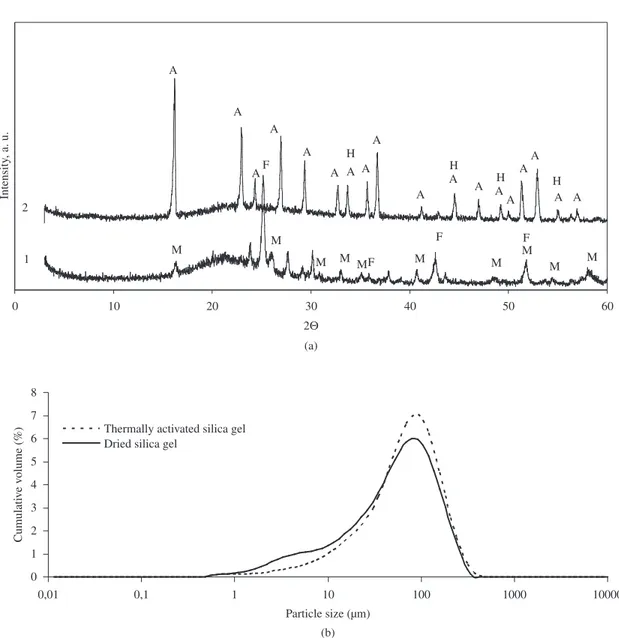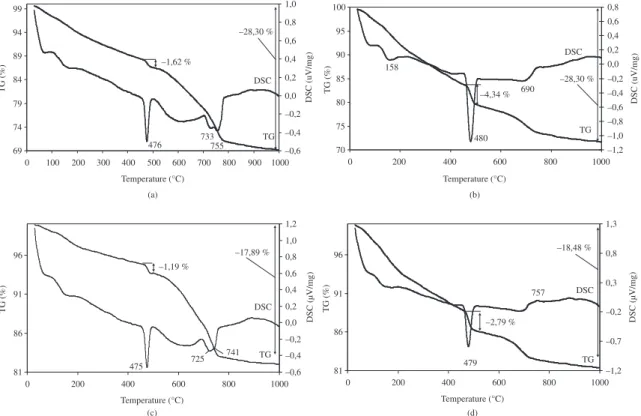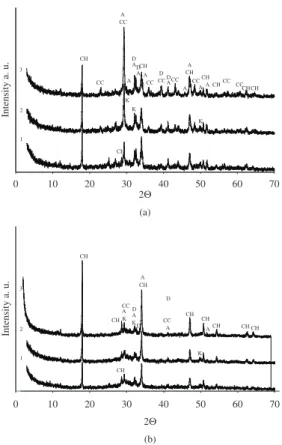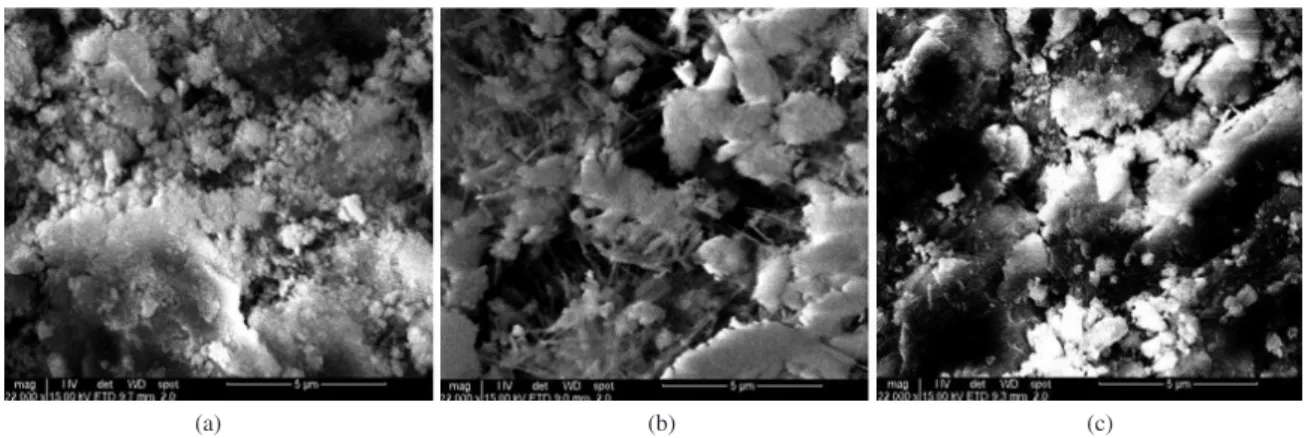*e-mail: danute.palubinskaite@ktu.lt
Utilization of By-Product Waste Silica in Concrete–Based Materials
Danute Vaičiukynienėa*, Vitoldas Vaitkevičiusa, Aras Kantautasb, Vytautas Sasnauskasa
aFaculty of Civil Engineering and Architecture, Kaunas University of Technology Studentų g. 48,
LT – 51367 Kaunas, Lithuania
bFaculty of Chemical Technology, Kaunas University of Technology Radvilėnų str. 19,
LT – 50254 Kaunas, Lithuania
Received: October 3, 2011; Revised: April 17, 2012
The usage of waste silica from AlF3 production is limited due to admixtures of fluoride in its composition. The negative effect of admixtures was eliminated by thermally activating this silica gel. After thermal activation the mineralogical composition of silica gel changes. Fluorine is binding in low-reactive compounds, which insignificant effect on the cement hydration process. The possibilities of using waste by-product silica in hardened cement paste were investigated. Silica gel could be used as additive of the hardened cement paste after thermal activation (1 hour at 800 °C temperature). It was discovered that the optimum content of thermally activated technogenic silica gel additive under the conditions explored was up to 10% of the total quantity of the cement. After 28 days of hardening, the strength of hardened cement paste increased 7 MPa when the quantity of the additive was – 10% of the total weight when compared to the strength qualities of the samples with no additives used.
Keywords: by product waste silica, concrete – based materials, AlF3 production wastes
1. Introduction
Phosphorites are decomposed by sulphuric acids in the production of phosphatic fertilizers. The reaction produces phosphoric and silicon hexafluoride acid, which, under the action of aluminium hydroxide, apart from the main product, i.e. aluminium fluoride, results the by-product silica gel SiO2⋅nH
2O. The usage of this silica gel is limited due to
the presence of aluminium fluoride in its composition. The negative effect of fluoride admixtures was eliminated by thermally activating the silica gel.
High purity silica is obtained by the reaction of impure waste by-product silica with hydrogen fluoride, producing silicon tetrafluoride gas and mother liquor1. The process is
used for converting silicon and fluorine-containing waste gases into silicon dioxide and hydrogen fluoride2. A method
for producing fumed silica and a fluorine-containing product from a source of silica in solid form was developed3.
Results of studies on applications of silica waste – a by-product of fluorine processing – as fillers for rubber mixtures, rubber vulcanizates and urethan elastomers are available. A procedure for utilizing silica by-products from aluminium fluoride production was developed in this research4,5.
The possibilities of producing binding materials by using waste product of AB Lifosafrom the AlF3 (silica
gel) industry were investigated6. The influence of the
composition of mixes (lime and waste products) and the conditions of the hardening process on the physical and mechanical properties of samples was analyzed. The optimal composition of lime, AlF3 waste product and phosphogypsum mix was determined. The results of
experiments confirmed the possibility of utilizing these waste products for the production of binding materials.
The synthesis of low-temperature zeolites is presented7.
For this synthesis it is possible to use this waste product (AlF3 production waste from Kedainiai and granulated silica fume from Norway) instead of reagent silica gel. Crystal zeolite – hydrosodalite has been synthesized using these silica gels. When using AlF3 production waste after 2 hours of isothermal exposure and the molar ratio of Na2O : Al2O3 : SiO2 : H2O = 2 : 1 : 2 : 10 hydrosodalite has been crystallized and sodium fluoride formed, which, when necessary, can be washed out.
In this study8, the effects of processes, in which the
repeatedly recycled coarse aggregate absorbed the colloidal silica solution as pozzolanic liquid, on the properties of concrete were investigated. The absorbed colloidal silica solution is assumed to fill the micro cracks of the aggregate and to change to C-S-H by pozzolanic reaction. With this technique, the strength of repeatedly recycled aggregate concrete was enough to construct ordinary concrete structures, and the capacity of shear transfer at the interface along diagonal tension cracks was improved.
Since most of the analysed silica gel is composed of amorphous SiO2,this silica gel acts in a similar manner as silica fume added in concretes and hardened cement paste. Direct tensile strength of hardened cement paste and mortar containing silica fume was evaluated at various water-cement ratios9. The results show that partial replacement of cement
of silica fume (16% and 25%) resulted in a decrease in the tensile strength of both the cement paste and the mortar.
The results10 indicate that silica fume content does not
significantly influence plastic shrinkage and settlement at investigated conditions. Another important observation was an immediate respond on external drying, which involves a low tensile strain capacity. The strain capacity seems to depend on the measured pore water pressure, which reflects the tensile stress in the pore water. The effect of silica fume content was not pronounced except for the sample with 15% admixture which showed a significantly higher rate of pressure drop than other concretes.
The authors have also established11,12 that silica fume
reacts with most of the Ca(OH)2 formed during hydration within 28 days and improves the compressive strength of the mortar. Silica fume accelerates the hydration of 3CaO·SiO2 (C3S), reduces the amount of calcium hydroxide by reacting with it, and slightly lowers the (1.5–2.0)CaO·SiO2⋅nH2O
(C–S–H) ratio of the C–S–H formed by hydration. Silica fume is considered a good model for reactive pozzolans used in concrete.
The results of the analysis13 also show that the increase
in compressive strength of mortar containing silica fume, as a partial replacement for cement, greatly contributes to strengthening the bond between the cement paste and the aggregate. Partial replacement of cement by silica fume and the addition of superplastisizer increase the strength of the mortar but have no influence on the strength of the cement paste.
Previous studies of M. Ilić et al. and A. Kutkaitis et al.14,15
have shown that dried silica gel prevents cement hydration and strength of the samples is reduced compared to standard samples.
M. Ilić et al.14 repot that the waste amorphous silica
obtained from AlF3 production could be used as additive in cement production. Experiments show that optimal quantity for the amorphous silica addition is 5% of the cement mass, but with this addition compressive strength was decreased, compared to standard sample.
The aim of this paper is to investigate the possibilities of using by product waste silica in hardened cement paste.
2. Material and Methods
2.1.
Materials
The Portland cement CEM I 52.5 R (specific surface – 370 kg.m–2, paste of normal thickness – 27.3%,
initial setting time – 130 minutes, final setting – 215 minutes) was used this study.
Silica gel dried at 100 °C and thermally activated at 800 °C with the composition showed in Table 1. Chemical composition of Portland cement showed in Table 1.
2.2.
Methods
The X-ray diffraction analysis using DRON − 6
diffractometer was conducted. The investigation was carried out with a 2Θ angle range 4 - 70° with Ni - filtered CuKα
radiation. Thermographic investigations were carried out by using differential scanning calorimeter STA 409 PC
manufactured by Netzsch. The maximum temperature was
1500 °C, and the velocity of the increase in temperature was 10 °C/min. IR spectra were recorded with Perkin Elmer FT-IR System spectrometer. For the IR analysis, 1 mg of the substance was mixed with 200 mg of KBr and compressed in a forming press under vacuum. Particle size distribution and specific surface area were determined by “Mastersizer 2000” instrument from Malvern. Red light was produced by helium-neon laser and blue light was obtained from a solid phase source. The measuring principle was used Mie scattering analysis. A high resolution scanning electron microscope FEI Quanta 200 FEG with a Schottky field emission gun (FEG). Chemical compositions of
modified AlF3 production waste were investigated by an energy-dispersive X-ray spectrometer (EDS) with silicon type drift droplet detector.
For the analysis of the effect of silica gel addition (5, 10, 15% of mass) on the properties of cement concrete, the series of cement paste mixtures were chosen and mixed in a laboratory. Samples were formed, i.e. prisms of 4 × 4 × 16 cm in size, that hardened for 28 days. The compression strength of hardened cement paste was evaluated based on EN 196-1 standard. An automated and computerized ToniTechnik 2020 press was used to evaluate the compression strength of hardened cement paste.
3. Results and Discussion
The temperature of thermal activation (800 ± 3 °C) was chosen according of the results of thermal analysis of silica gel (Figure 1). The results showed that AlF3⋅3.5H
2O
loses three molecules of crystallization water at 187 °C. In the temperature range from 187 to 734 °C SiO2⋅nH2O
gradually dehydrates. At 734 °C AlF3 completely loses hydration water. With the further increase of temperature, SiO2⋅nH
2O and AlO(OH) dehydrate. The total ignition loss
up to 1000 °C was 41.33%.
The X-ray diffraction analysis showed that dried silica gel (Figure 2a, Cr. 2) contained amorphous SiO2⋅nH
2O, also
AlF3⋅3.5H
2O and AlO(OH). When silica gel was heated at
Table 1. Chemical composition % of Portland cement CEM I 52.5 R, dried and thermally activated silica gel.
Chemical composition Portland cement clinker Thermally activated silica gel Dried silica gel
SiO2 21.00 60.15 60.54
Al2O3 3.90 4.43
-AlF3 - 35.52
-AlO(OH) - - 2.99
AlF3⋅3.5H2O - - 36.47
Fe2O3 2.90 -
-CaO 66.00
-SO3 3.40 -
-Cl– 0.06 -
-MgO 2.70 -
-C3S 50.7 -
-C2S 18.5 -
-C3A 9.7 -
-800 °C for 1 hour, its mineral composition changed: in addition to amorphous SiO2,synthetic mulite Al4.95Si1.05O9.52 and dehydrated AlF3 were also formed. Chemical analysis results of dried silica gel showed in Table 1.
The negative effect of fluoride admixtures was eliminated by thermally activating this silica gel. After thermal activation the mineralogical composition of silica gel changes. Fluorine is binding in a low-reactive compounds: AlF3 and Al4,95Si1,05O9,52, which insignificant effect on the cement hydration process.
The strength of hardened cement paste specimens depends on the granular composition of the aggregates. The particle size and size distribution analysis has revealed that the diameters of silica gel particles are similar: in dried and thermally activated silica gel waste range from 79.4 to 91.20 µm (Figure 1b). However, the specific surface area was a slightly increased for thermally activated silica gel. The specific surface area for dried silica gel was S = 0.27 m2.
cm–3, and for thermally activated silica gel S = 0.39 m2.cm–3
corresponding to an average particle size.
The influence of dried silica gel on the strength of the hardened cement paste was investigated. It was determined
Figure 2. Distribution of silica gel particles (a) and X-ray diffraction patterns of silica gel (b): 1 – test sample thermally activated for 1 hour at 800 °C; 2 – test sample dried at 100 °C. *Notes – A – AlF3⋅3.5H
2O; M – Al4,95Si1,05O9,52; F – AlF3; H – AlO(OH).
that samples with a larger amount of this silica gel were weaker (Figure 3). For example, the compression strength of the samples with 15% of dried silica gel in hardened cement paste after 28 days decreased about 33 MPa when comparing to the specimens without any additives. These result confirmed the literature data14,15, that dried silica gel
prevents cement hydration and strength of the samples is reduced compared to standard samples.
The characteristics of silica gel changed substantially after they were thermally activated. It was determined
that the 10% addition of thermally activated silica gel to the total amount of cement increased the strength of the samples about 7 MPa when compared to the samples without additives (Figure 3). When the quantity of activated silica gel was increased more than 10%, the strength decrease. The
strength of the samples that contained 15% of silica gel and hardened for 3 days was 2.5–5 MPa bigger when compared to the control samples.
Afterwards, the samples that contained only thermally activated silica gel were investigated.
Thermogravimetric analysis (Figure 4) of hardened cement paste showed that when the quantity of silica gel was increased from 0 to 15%, the quantity of Ca(OH)2 in the mineral composition of the hardened cement paste decreased from 7 to 5 mg.g–1 respectively when the sample had been
hydrated for 3 days; and from 18 to 11 mg.g–1 after 28 days
of hydration. The analysis of X-ray diffraction patterns showed that the peaks of 0,493 nm inter-plane distances of Ca(OH)2 were more intensive when no admixture was used, whereas less intensive peaks were noticed when 15 percent of silica gel admixture had been used (Figure 5).
After 3 days of hydration (Figure 4) of samples without admixture, calcitephase appeared as a secondary reaction of Ca(OH)2 with atmospheric CO2. The quantity of calcite decreased or it did not form in the samples where the admixture of silica gel was used and the samples were hardening for 28 days.
Thermographic analyses (Figure 4) showed that endothermal peaks of DSC curves for the temperature range between 100 and 200 °C indicated the elimination of water at C-S-H phase16. The second intensive endothermic peak for
Figure 4. Thermograms of the hardened cement paste after the curing time for 3 (a, c) and 28 (b, d) days without (a, b) and with 10% (c, d) of thermally activated silica gel addition.
Figure 6. The FT-IR - spectra of hardened cement paste after 3 days (a) and after 28 days (b) containing: 1 – 0%; 2 – 10% and 3 – 15% of silica gel.
the temperature range between 475 and 480 °C indicated the dissociation of portlandite Ca(OH)217,18. Endothermal peaks
for the temperature range between 690 and 733 °C can be attributed both to CaCO3 decomposition and indicated the dehydration of calcium hydrosilicate which was similar to tobermorite at C-S-H phase. The exothermal peaks for the temperature range metween 750 and 757 °C attributed to the CaCO3 decomposition16,18.
In the range between 3100-3700 cm−1, the H 2O and
OH stretching bands appeared. IR spectra of the samples of hardened cement paste (Figure 6) with well-defined wide band of absorption in the 3420-3430 cm–1 area
indicated fluctuation and deformation of – OH hydroxyl group that belonged to intermolecular hydrogen bonds. A narrow band of absorption in the 3643-3644 cm–1 area
indicated – OH fluctuations of Ca(OH)2 portlandite19. The
quantity of silica gel used in the samples influenced the quantity of portlandite. When silica gel was not used in the samples a small increase of the OH− band, associated with
Ca(OH)2 molecules, was recorded in the range between 3643 and 3644 cm−1 when compared to the samples when
silica gel was used.
The absorption bands in the 2517; 1796; 1447 and 875 cm–1 areas of the spectrum were common to the
fluctuations of carbonates of calcium carbonate19. It is
possible to state that the quantity of CaCO3 in the hardened cement paste decreased when the admixture was added as the intensity of absorption bands were directly proportional to the concentration of these groups. With admixture added all CaCO3 peaks decreased proportionally, especially the band of absorption in the 875 cm–1 area. When the maximum
quantity of 15% of admixture had been added, the bands of absorption in the 2517 and 1796 cm–1 area disappeared. The
decrease in the quantity of CaCO3 in the samples with silica gel admixture was more intense after 3 days of hydration. After 28 days of hydration CaCO3 joined the structure of calcium hydro silicates, and carboxylates were formed20.
The most intensive bands of absorption were observed in the range between 971-988 cm–1. These absorption
bands attributed to atomic frequencies of (Si, Al) - O bond in tetrahedron along the lines that bind [(Si, Al)O4]–4
tetrahedron oxygen atom with central Si or Al atom. Ettringite formation was identified from the peaks in the range of 3420-3430 and 1112 cm–1 area of absorption, and
these vibrations were identified as S–O vibrations. Peaks pointing to the early formation of ettringite at the range of ~1122 cm–1 were detected after 3 days of hydration.
It was proved that thermally activated silica gel acted as an active mineral addition; it also reacted with calcium hydroxide and formed a stable C-S-H form of calcium hydrosilicate (Figure 7). The established hydraulic activity of silica gel was 108 mg CaO/g. The SEM picture of the hardened cement paste with 10% of admixture used revealed needle crystals of calcium hydrosilicates. This observation suggests that this admixture forced the formation of calcium hydrosilicate.
In conclusion, it can be stated that part of concrete in concrete products can be replaced by thermally activated silica gel and this admixture actively participates in the process of hardened concrete paste hydration.
with Ca(OH)2 and form (C–S–H) type calcium silicate hydrates that additionally strengthened the hardened cement paste;
• ItwasdeterminedthequantityofCa(OH)2 decreased from 7 to 5 mg.g–1 after 3 days of hydration, and from
18 to 11 mg.g–1 after 28 days of hydration when the
quantity of silica gel additive in the samples had been increased from 0 to 15%; and
• After 28 days of hardening, the strength of the
hardened cement paste increased 7 MPa (with 10% additive), compared with the control specimen without additives. This quantity of silica gel additive enables to decrease the quantity of used cement.
4. Conclusions
From the research presented herein, the following conclusions can be derived:
• The negative effect of luoride admixtures can be
eliminated in AlF3 production waste by thermally activating this silica gel. After thermal activation the mineralogical composition of silica gel changes. Fluorine is binding in a low-reactive compounds, which insignificantly effect on the cement hydration process;
• Itwasexperimentallyconirmedthatthethermally
activated silica gel could be used as an additive in hardened cement paste. This amorphous SiO2 reacted
Figure 7. SEM of hardened cement paste containing 0% (a), 10% (b) and 15% (c) of silica gel.
References
1. Erickson WR. Process for the production of high purity silica from waste by-product silica and hydrogen fluoride. US Patent 5853685. 1996.
2. Flemmert GL. Process for converting silicon and fluorine containing waste gases into silicon dioxide and hydrogen fluoride. US Patent 3969485. 1974.
3. Barnett RJ and Mezner MB. Production of fumed silica. US Patent 6217840. 1999.
4. Krysztafkiewicz A, Maik M and Rager B. Comparison of waste silica fillers modified with various proadhesive compounds. Journal of Materials Science. 1992; 27:3581-3588. http:// dx.doi.org/10.1007/BF01151836
5. Krysztafkiewicz A, Rager B and Maik M. Silica recovery from waste obtained in hydrofluoric acid and aluminum fluoride production from fluosilicic acid. Journal of Hazardous Materials. 1996; 48:31-49. http://dx.doi. org/10.1016/0304-3894(95)00126-3
6. Mandeikytė N, Rumša R and Urbonas L. Binding materials on the basis of technogenical raw materials. Cheminė
Technologija. 2002; 2(23):19-24. (in Lithuanian).
7. Palubinskaitė D and Kantautas A. Synthesis of Zeolite using technogenical silicagel. C h e m i nė
Technologija. 2005; 4(38):35-40. (in Lithuanian).
8. Takehiro S and Masanori T. Effect of absorption of colloidal silica solution into repeatedly recycled coarse aggregate on properties of concrete. Proceedings of JSCE (Japan Society of Civil Engineers). 2003; 725:57-70.
9. Toutanji HA, Liu L and El-Korchi T. The role of silica fume in the direct tensile strength of cement-based materials. Materials and Structures. 1999; 32:203-209. http://dx.doi.org/10.1007/ BF02481516
10. Hammer TA. Effect of silica fume on the plasticshrinkage and pore water pressure of high-strength. Materials and Structures. 2001; 34:273-278.
11. Cheng H and Feldman RF. Influence of silica fume on themicrostructural development in cement mortars. Cement and Concrete Research. 1985; 15:285-294. http://dx.doi. org/10.1016/0008-8846(85)90040-7
12. Wu Z and Young JF. The hydration of tricalcium silicate in the presence of colloidal silica. The hydration of tricalcium silicate in the presence of colloidal silica. Journal of Materials
Science. 1984; 11:3477-3486. http://dx.doi.org/10.1007/
BF02396922
13. Toutanji HA and El-Korchi T. The influence of silica fume on the compressive strength of cement paste and mortar. Cement and Concrete Research. 1995; 25:1591-1602. http://dx.doi. org/10.1016/0008-8846(95)00152-3
14. Ilić M, Miletić S and Stefanović M. Air pollution protection by waste amorphous SiO2 utilization in Portland cement production. Toxicological & environmental ch e m i s t r y. 1999; 69(1-2):209-215. http://dx.doi. org/10.1080/02772249909358702
18. Zifang X, Mingxu Zh and Fanfei M. Investigation for Reaction mechanism of nano-silica-modified cement-based composite materials. Integrated Ferroelectrics. 2011; 129:160-168. 19. Šiaučiūnas R, Baltakys K and Baltušnikas A. The instrumental
analysis of silicate materials. Kaunas: Vitae Litera; 2007 (in Lithuanian).
20. Pera J, Husson S and Guilhot B. Influence of finely ground limestone on cement hydration. Cement & Concrete Composites. 1999; 21:99-105. http://dx.doi.org/10.1016/ S0958-9465(98)00020-1
Calcium Hydro Silicates and Their Application. 1990:152-155. (in Lithuanian).
16. Kaminskas R. The effect of pozzolana on the properties of the finest fraction of separated portland cement. Part II. Ceramics-silikaty. 2008; 52:183-189.



